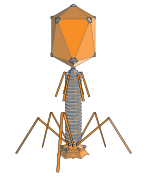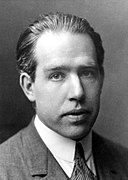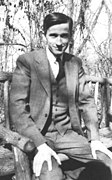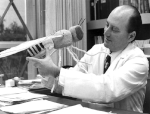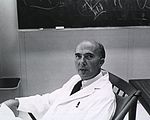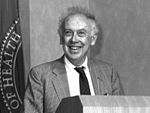American Phage Group
Jump to navigation
Jump to search
English: The phage group (sometimes called the American Phage Group) was an informal network of biologists centered around Max Delbrück that contributed heavily to bacterial genetics and the origins of molecular biology in the mid-20th century.
Bacteriophage: a very simple model organism[edit]
Bacteriophage[edit]
-
The structure of a typical myovirus bacteriophage
-
Electron micrograph of bacteriophages attached to a bacterial cell. These viruses are the size and shape of coliphage T1
-
Diagram of a typical tailed bacteriophage structure
-
Structure of Bacteriophage T4
-
Phage injecting its genome into bacterial cell
Discovery of bacteriophages[edit]
-
Frederick W. Twort the original discoverer in 1915 of bacteriophages (viruses that infect bacteria)
Origins of the Phage Group[edit]
Influence of physical scientists in biology[edit]
Max Delbrück: a physicist-turned biologist[edit]
-
Max Delbrück
-
Max Delbrück (last years)
-
Lytic cycle, compared to lysogenic cycle
Salvador Luria[edit]
-
Salvador E. Luria ca. 1969
-
Salvador Luria and his wife Zella, on the beach at Cold Spring Harbor
Started of the Phage Group[edit]
The phage group started around 1940, after Delbrück and Luria had met at a physics conference. Delbrück and Luria began a series of collaborative experiments on the patterns of infection for different strains of bacteria and bacteriophage.
-
Salvador Luria and Max Delbrück at Cold Spring Harbor Laboratory
Luria–Delbrück experiment (1943)[edit]
The Luria–Delbrück experiment (1943) (also called the Fluctuation Test) demonstrates that in bacteria, genetic mutations arise in the absence of selection, rather than being a response to selection.
-
Diagram illustrating the two possibilities tested by the Luria-Delbrück experiment
Phage course at Cold Spring Harbor Laboratory (1945)[edit]
Apart from direct collaborations, the main legacy of the phage group resulted from the yearly summer phage course, starting in 1945, at Cold Spring Harbor Laboratory.
-
Cold Spring Harbor Laboratory
Notable scientists associated with the Phage Group[edit]
-
Seymour Benzer with a Drosophila model, 1974
